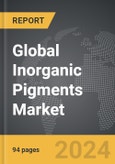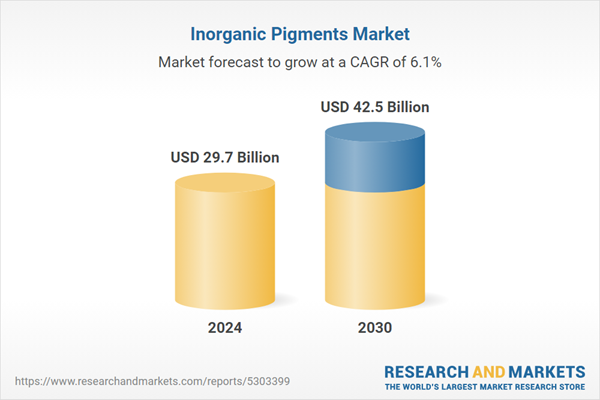Global Inorganic Pigments Market - Key Trends and Drivers Summarized
Why Are Inorganic Pigments Essential in Manufacturing and Construction?
Inorganic pigments play a crucial role in industries such as manufacturing, construction, and consumer goods, offering color and functional properties that enhance product durability, aesthetics, and performance. Derived from natural minerals or synthesized through chemical processes, inorganic pigments are used in paints, coatings, plastics, and ceramics due to their superior heat resistance, lightfastness, and chemical stability. These pigments are widely favored for outdoor applications, including building materials and automotive coatings, as they provide long-lasting color retention and protection against environmental degradation. Their utility in manufacturing extends to coloring plastics, textiles, and even cosmetics, making inorganic pigments a versatile and indispensable component across various sectors.How Are Technological Advancements Shaping the Inorganic Pigments Market?
Technological advancements are significantly enhancing the performance and environmental sustainability of inorganic pigments. Innovations in pigment synthesis, including nano-sized pigments, are improving color intensity and dispersion properties, making them more effective in a wider range of materials. Moreover, the development of environmentally friendly pigments, such as low-toxicity and heavy-metal-free alternatives, is gaining traction as industries focus on reducing their environmental impact and meeting regulatory requirements. Advances in surface modification technologies are also allowing for better pigment stability in harsh environmental conditions, extending their application in coatings and outdoor products. These technological improvements are broadening the use of inorganic pigments across more demanding industrial applications.How Do Market Segments Define the Growth of the Inorganic Pigments Market?
Key pigment types include titanium dioxide, iron oxide, chromium oxide, and carbon black, with titanium dioxide leading the market due to its widespread use in paints, coatings, and plastics for its excellent opacity and brightness. Applications range from paints & coatings and plastics to construction materials and personal care products, with paints & coatings being the largest application segment driven by construction and automotive industries. End-use industries include construction, automotive, packaging, and personal care, with construction leading the market due to the extensive use of pigments in building materials. The market is growing rapidly in regions such as Asia-Pacific, where construction and automotive manufacturing are expanding significantly.What Factors Are Driving the Growth in the Inorganic Pigments Market?
The growth in the inorganic pigments market is driven by several factors, including the increasing demand from the construction and automotive industries, advancements in pigment technology, and a growing focus on sustainability. As construction projects worldwide continue to rise, the demand for durable pigments in paints, coatings, and building materials is increasing. In the automotive sector, inorganic pigments are used extensively in vehicle coatings, enhancing both aesthetics and durability. Technological advancements in producing high-performance, eco-friendly pigments are also expanding their application in industries looking to reduce their environmental footprint. Moreover, regulations surrounding the use of toxic materials are prompting manufacturers to shift toward safer, sustainable pigment options, further driving market growth.Report Scope
The report analyzes the Inorganic Pigments market, presented in terms of market value (US$ Thousand). The analysis covers the key segments and geographic regions outlined below.- Segments: Pigment Type (Titanium Dioxide, Iron Oxide, Carbon Black, Other Types); Application (Paints & coatings, Plastics, Inks, Other Applications).
- Geographic Regions/Countries:World; United States; Canada; Japan; China; Europe (France; Germany; Italy; United Kingdom; Spain; Russia; and Rest of Europe); Asia-Pacific (Australia; India; South Korea; and Rest of Asia-Pacific); Latin America (Argentina; Brazil; Mexico; and Rest of Latin America); Middle East (Iran; Israel; Saudi Arabia; United Arab Emirates; and Rest of Middle East); and Africa.
Key Insights:
- Market Growth: Understand the significant growth trajectory of the Titanium Dioxide segment, which is expected to reach US$16.1 Billion by 2030 with a CAGR of a 6.8%. The Iron Oxide segment is also set to grow at 6.1% CAGR over the analysis period.
- Regional Analysis: Gain insights into the U.S. market, valued at $7.7 Billion in 2024, and China, forecasted to grow at an impressive 9.3% CAGR to reach $9.9 Billion by 2030. Discover growth trends in other key regions, including Japan, Canada, Germany, and the Asia-Pacific.
Why You Should Buy This Report:
- Detailed Market Analysis: Access a thorough analysis of the Global Inorganic Pigments Market, covering all major geographic regions and market segments.
- Competitive Insights: Get an overview of the competitive landscape, including the market presence of major players across different geographies.
- Future Trends and Drivers: Understand the key trends and drivers shaping the future of the Global Inorganic Pigments Market.
- Actionable Insights: Benefit from actionable insights that can help you identify new revenue opportunities and make strategic business decisions.
Key Questions Answered:
- How is the Global Inorganic Pigments Market expected to evolve by 2030?
- What are the main drivers and restraints affecting the market?
- Which market segments will grow the most over the forecast period?
- How will market shares for different regions and segments change by 2030?
- Who are the leading players in the market, and what are their prospects?
Report Features:
- Comprehensive Market Data: Independent analysis of annual sales and market forecasts in US$ Million from 2024 to 2030.
- In-Depth Regional Analysis: Detailed insights into key markets, including the U.S., China, Japan, Canada, Europe, Asia-Pacific, Latin America, Middle East, and Africa.
- Company Profiles: Coverage of players such as Alabama Pigments Company, Cabot Corporation, Carl Schlenk AG, Cathay Industries, Clariant and more.
- Complimentary Updates: Receive free report updates for one year to keep you informed of the latest market developments.
Some of the 43 companies featured in this Inorganic Pigments market report include:
- Alabama Pigments Company
- Cabot Corporation
- Carl Schlenk AG
- Cathay Industries
- Clariant
- Dominion Colour Corporation
- Dystar
- Eckart GmbH
- Ferro Corporation
- Habich GmbH
- Heubach GmbH
- Ineos Pigments
- Jiangsu Yuxing Industry & Trade Co., LTD.
- Kronos Worldwide, Inc.
- Lanxess
- Lomon Billions
- Matapel Chemicals
- National Industrialization Company (Tasnee)
- Sudarshan Chemicals
- Sun Chemical
- Tata Pigments
- The Chemours Company
- Tronox Limited
- Venator
- Zhejiang Huayuan Pigment Co., LTD.
This edition integrates the latest global trade and economic shifts into comprehensive market analysis. Key updates include:
- Tariff and Trade Impact: Insights into global tariff negotiations across 180+ countries, with analysis of supply chain turbulence, sourcing disruptions, and geographic realignment. Special focus on 2025 as a pivotal year for trade tensions, including updated perspectives on the Trump-era tariffs.
- Adjusted Forecasts and Analytics: Revised global and regional market forecasts through 2030, incorporating tariff effects, economic uncertainty, and structural changes in globalization. Includes historical analysis from 2015 to 2023.
- Strategic Market Dynamics: Evaluation of revised market prospects, regional outlooks, and key economic indicators such as population and urbanization trends.
- Innovation & Technology Trends: Latest developments in product and process innovation, emerging technologies, and key industry drivers shaping the competitive landscape.
- Competitive Intelligence: Updated global market share estimates for 2025, competitive positioning of major players (Strong/Active/Niche/Trivial), and refined focus on leading global brands and core players.
- Expert Insight & Commentary: Strategic analysis from economists, trade experts, and domain specialists to contextualize market shifts and identify emerging opportunities.
Table of Contents
Companies Mentioned (Partial List)
A selection of companies mentioned in this report includes, but is not limited to:
- Alabama Pigments Company
- Cabot Corporation
- Carl Schlenk AG
- Cathay Industries
- Clariant
- Dominion Colour Corporation
- Dystar
- Eckart GmbH
- Ferro Corporation
- Habich GmbH
- Heubach GmbH
- Ineos Pigments
- Jiangsu Yuxing Industry & Trade Co., LTD.
- Kronos Worldwide, Inc.
- Lanxess
- Lomon Billions
- Matapel Chemicals
- National Industrialization Company (Tasnee)
- Sudarshan Chemicals
- Sun Chemical
- Tata Pigments
- The Chemours Company
- Tronox Limited
- Venator
- Zhejiang Huayuan Pigment Co., LTD.
Table Information
| Report Attribute | Details |
|---|---|
| No. of Pages | 286 |
| Published | December 2025 |
| Forecast Period | 2024 - 2030 |
| Estimated Market Value ( USD | $ 29.7 Billion |
| Forecasted Market Value ( USD | $ 42.5 Billion |
| Compound Annual Growth Rate | 6.1% |
| Regions Covered | Global |









